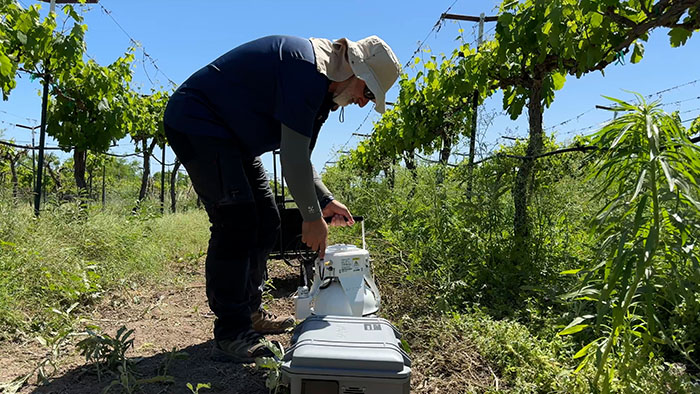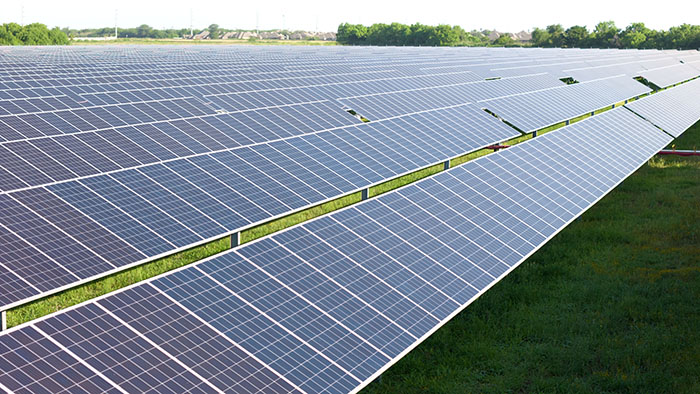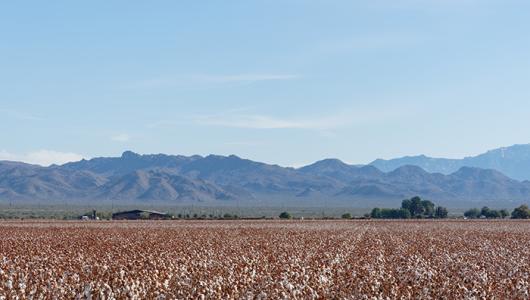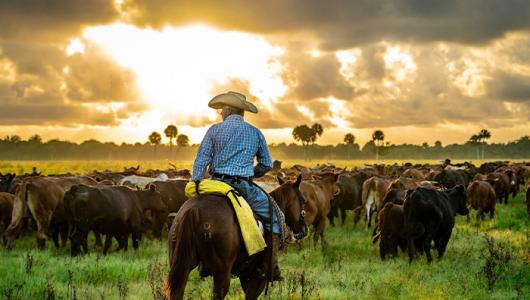Clusters of dark grapes ripen under a relentless sun at Nora and Delfino Garza’s Dos Rios Winery, a 15-acre property that lies adjacent to the Rio Grande and San Juan rivers in Rio Grande City, Texas. Though the hot climate helps the Garzas produce early ripening grape varieties including Blanc Du Bois, Le Noir Black Spanish, and Chardonnay, they are hoping to incorporate an agrivoltaic system, which co-locates agriculture and solar power, to shade the vines, reduce water usage, and improve yields.
The Garzas are a part of the University of Texas Rio Grande Valley’s Agrivoltaic Climate-Smart Ag Markets project, one of approximately 140 grant projects being funded by the USDA’s Partnerships for Climate-Smart Commodities. USDA is investing $3 billion to build and expand markets for commodities made with climate-smart practices. The department hopes to increase the competitive advantage of U.S. agriculture both domestically and internationally, building wealth in rural communities. These climate-smart projects support a diverse range of producers and operations as they voluntarily adopt climate-smart agricultural practices and market their climate-smart commodities.

Through the Agrivoltaic Climate-Smart Ag Markets project, the University of Texas Rio Grande Valley (UTRVG) and its partners are working to pilot climate-smart and innovative agrivoltaics, measure and evaluate the greenhouse gas benefits from the agrivoltaics systems and build equitable climate-smart commodity markets for area Hispanic farmers and ranchers.
“The Rio Grande Valley carries a rich agricultural history,” Deputy Under Secretary for Farm Production and Conservation Gloria Montaño Greene said. “As the region’s producers face higher temperatures and stress on water supplies, efforts like the University of Texas Rio Grande Valley’s Agrivoltaic Climate-Smart Ag Markets project are critical in developing science-based solutions to mitigate climate change impacts and build a more resilient agricultural system for the future while providing additional revenue streams for producers.”
Through the project, UTRVG hopes to prove a number of climate-smart benefits to co-locating solar power and agriculture, including increased land use efficiency, clean energy production, and water use reduction.
“We started growing our grape vines in 2010. It has taken a lot of effort and hard work to get to where we are now,” Dos Rios Winery owner Nora Garza said. “We are hoping the panels will provide a better climate for the vines and help us reduce the amount of water that we use.”
Many area producers, like the Garzas, are small-scale operations that focus on specialty crops and livestock, relying on irrigation systems and operating on very tight margins. Environmental challenges such as drought conditions, hurricanes and other severe weather patterns can interrupt cash flow and put farmers in a precarious position. Agrivoltaics allows farmers to maximize land-use efficiency, creating dual-revenue streams and building economic and environmental resilience into their operations.
“We just opened a tasting room, which will take our winery to the next level and attract people to the region,” Dos Rios Winery owner Delfino Garza said. “We have to heat and cool this building, as well as cool the wine during the fermentation process and that’s a lot of electricity. We think the solar panels will help reduce that cost by providing clean energy.”
In addition to replacing fossil fuels with renewable energy, agrivoltaic systems can also reduce greenhouse gas emissions from the soil and improve carbon storage via the cooler microclimates created by solar panel shading. That shading also helps the soil retain more moisture, helping producers use water resources more effectively.
The UTRVG team uses cutting-edge greenhouse gas analyzers to measure exactly how much carbon dioxide, methane, and nitrous oxide is being emitted into the air, and how the climate-smart production practices reduce those emissions. The team stresses the importance in quantifying the impact that these climate-smart practices have on the landscape in order to fully understand how sustainable agricultural practices can benefit the region’s farmers.

UTRVG hopes that the data collected through the Agrivoltaic Climate-Smart Ag Markets project can pave the way for the incorporation of agrivoltaics into the USDA’s standard practices, expanding the agency’s toolbox in providing financial and technical assistance to producers to fight climate change.
A large part of the project is dedicated to working with area producers to overcome the operational, economic, and cultural barriers in adopting agrivoltaics. The Rio Grande Valley is home to the highest concentration of Hispanic farmers and ranchers in the country. The University of Texas Rio Grande Valley, as the second largest Hispanic-serving institution in the U.S., has extensive experience in working with underserved groups to promote climate-smart activities.
“Through the university and the center, we have been able to establish a network of farmers and ranchers,” Center of Sustainable Agriculture and Rural Advancement Executive Director Colin Kane said. “We have built relationships in these communities enough so that they trust us to be honest and direct about the pros and cons of incorporating agrivoltaic systems into their operations.”
Kane and his staff are working directly with area farmers to provide technical assistance and troubleshoot any issues that arise in the installation, operation, and maintenance of the agrivoltaic systems. All technical assistance materials, tools, and trainings are delivered in both English and Spanish to ensure that materials are communicated in a linguistically and culturally appropriate manner.

The University of Texas Rio Grande Valley is also working to develop avenues to connect enrolled producers to retail and wholesale buyers to sell their climate-smart commodities.
“A key aspect of our project is to evaluate whether consumers value the unique attributes of products cultivated using agrivoltaics,” Agrivoltaic Climate-Smart Ag Markets Project Director Dr. Engil Pereira said. “This insight will enable farmers and retailers to effectively market agrivoltaic-grown food, aligning their strategies with consumer preferences.”
By supporting a diverse range of producers and operation types, USDA and its partners are innovating a number of climate-smart solutions that impact numerous natural resource concerns while also strengthening rural economies by diversifying revenue streams. To learn more about University of Texas Rio Grande Valley Agrivoltaic Climate-Smart Ag Markets project and other Partnerships for Climate-Smart Commodities projects, visit the project dashboard. Interested producers can learn more about projects in their state by commodity type and climate-smart practice implementation and can access project sign-ups via the site.
Brooke DeCubellis, Partnerships for Climate-Smart Commodities Communications Coordinator, can be reached at brooke.decubellis@usda.gov


